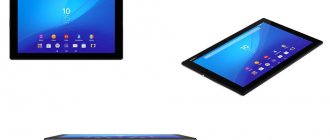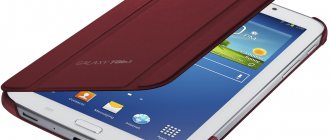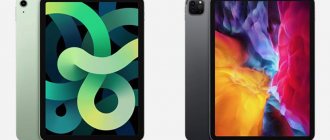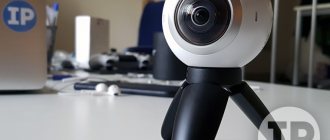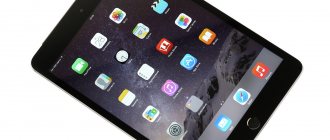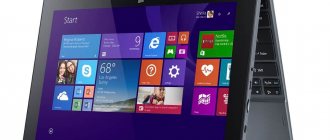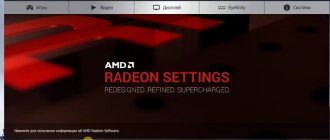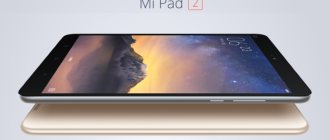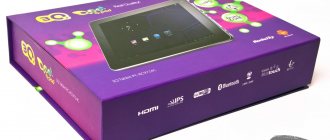Awkward design
LG is keeping the design consistent across all three of its new tablets. The case is normal, matte back, silky, slightly elastic structure to avoid fingerprints.
LG G Pad's Awkward Design
LG G Pad's Awkward Design
LG G Pad's Awkward Design
LG G Pad's Awkward Design
In the LG G PAD, the thickness of the side walls is about 1 cm. This, of course, is not very much. But it is not very comfortable to hold in one hand. The extra space on the 10-inch G Pad doesn't have much of a purpose.
Android KitKat looks good with a few touches from LG
LG G Pad interface
LG G tablets come with Android 4.4.2 KitKat pre-installed. The interface is neat and clean, with a few major differences from way Android, everything works and looks fine. The South Korean manufacturer has indeed added some interesting features, such as a pair of Q 2.0, allowing you to connect Android smartphones to the tablet to view important information on the big screen. There is a 2-window mode option with which you can check Google Hangouts while you are watching a YouTube video or browsing the web. There is even a special button on the touch screen for this function - it is located next to the menu button.
Android on LG G Pad
To open two applications at the same time, simply click on the button and select the applications in the pop-up window. Then, you can select the apps you want to see. Once they appear, you can adjust the size of the window to your liking. Tablets have a great security feature that allows you to set a lock in a specific sequence when you press the screen.
LG G PAD operation
All three G tablets are equipped with 1280 ? IPS displays. 800 pixels. The only difference is the screen size. Although the display isn't Full HD, the picture actually looks pretty good when watching videos on YouTube or Netflix. The lack of extra pixels is a little more noticeable on the larger 10.1-inch G Pad. If you like to watch 1080p movies on your tablet, you'll be very disappointed by the low resolution. And the G Pad 10.1 probably isn't for you. LG has included a 1.2GHz quad-core Qualcomm Snapdragon processor and 1GB of RAM inside all three G-tablets. In performance tests, the G devices performed quite well.
LG G PAD operation
The smallest model only comes with 8GB of internal memory, but the LG G Pad 8.0 and 10.1-inch tablets come with 16GB. We strongly recommend that you start with at least 16 GB. Luckily, all three have MicroSD card slots. In terms of connectivity, G tablets offer Wi-Fi 802.11a/b/g/n, Bluetooth 4.0 and GPS.
LG G Pad equipment
LG G Pad equipment
LG G Pad equipment
And we can too! Test and review of the LG G Pad 8.3 tablet
Table of contents
- Introduction
- Specifications
- Packaging and delivery
- Appearance and design
- Display
- Hardware platform and performance
- Software
- Multimedia
- Wireless Interfaces and Communications
- Memory and file system
- Battery life
- Camera
- Comparison with competitors
- Conclusion
Introduction
Most companies have already presented their variations on the theme of tablet computers.
On sale you can find not only Apple products, but also ASUS, Lenovo, Samsung and many others. LG needs no introduction; the company has recently been making confident strides in the field of top-end smartphones. We have already written about the LG G2, LG Optimus G Pro and LG G Flex. LG smartphones always presented surprises in the form of a curved body, buttons on the back panel, or at least were interesting in the little things. It was not without its annoying shortcomings. What awaits us now that the G line lacks a larger device? LG decided that it was not worth falling behind its competitors, and presented its tablet LG G Pad 8.3 (LG-V500) at the last IFA exhibition.
Of course, this is not the first attempt by a Korean company to take its rightful place among the solutions of other manufacturers. There were, for example, the LG Optimus Pad and the tablet-like LG Optimus Vu. But LG products in this segment of mobile devices did not find much demand or excitement among buyers. And now we are looking at not just another “tablet”, but the world’s first 8.3-inch tablet equipped with a display with a resolution of 1920 x 1200 pixels.
announcements and advertising
2080 Super Gigabyte Gaming OC for 60 rubles.
Compeo.ru - the right comp store without any tricks
RTX 2060 becomes cheaper before the arrival of 3xxx
Ryzen 4000
series included in computers already in Citylink
The price of MSI RTX 2070 has collapsed after the announcement of RTX 3xxx
Core i9 10 series is half the price of the same 9 series
The price of memory has been halved in Regard - it’s more expensive everywhere
Such high screen parameters require appropriate hardware capabilities. With this, everything is fine with the LG G Pad 8.3: a quad-core Qualcomm Snapdragon 600 processor, 2 GB of RAM and decent graphics. If the device was released by LG, then we must face not only good design, high quality manufacturing, but also a non-standard and rich interface, replete with all sorts of services.
True, LG may scare away the lion's share of potential buyers when they find out that the tablet does not have a 3G or LTE version. At least now in Russia only the Wi-Fi option is available. Often the cellular module is important, because otherwise the device from being a useful assistant in many situations can turn into an unnecessary piece of hardware. In some other countries, options with a SIM card have already appeared, so it is still possible to get such a device if you wish (the Internet can help).
The tablet was announced and went on sale at a bad time. Seeing the white light, he immediately found the Apple iPad mini with Retina display, ASUS Nexus 7 and Samsung Galaxy Note 8.0, which all have their own strengths. Well, our task is to find out what the next “Pad”, now made by LG, will actually be good for.
Specifications
| operating system | Android 4.2.2 (update to 4.4.2), LG Optimus UI shell |
| Housing materials | Plastic, metal |
| Screen | 8.3 inches, IPS, 1920 x 1200, 273 ppi |
| CPU | 4 cores, 1.7 GHz, Qualcomm Snapdragon 600 |
| Video processor | Adreno 320 |
| RAM | 2 GB |
| Persistent memory | 16 GB, supports Micro SD memory cards up to 64 GB |
| Interfaces and data transfer | USB 2.0, Wi-Fi (b/g/n), Bluetooth 4.0, GPS, IR port |
| Cameras | 5 megapixel main with autofocus, 1.3 megapixel front |
| Battery | 4600 mAh |
| Basic sensors and sensors | Light sensor, accelerometer, gyroscope |
| Dimensions | 217 x 126 x 8.3 mm |
| Weight | 338 g |
| Price | 12,000–16,000 rubles |
The high resolution of the screen allows us to achieve the pixel density necessary for the visual sensation of high-definition images. The processor, graphics accelerator and amount of RAM should ensure smooth operation, and the small weight and size should ensure ease of use. In my opinion, a diagonal of about 8 inches seems most optimal.
The LG model is equipped with 16 GB of storage, but the issue of data storage space is resolved using a memory card. Cameras are not a strong point here, but in such a device this is of no fundamental importance. At first glance, a capacious battery may not be sufficient to ensure long-term operation of the local screen. But the software part should please you with a beautiful and functional interface, and the body will provide a pleasant feeling due to the use of metal in the design.
In our market, the tablet is available in one hardware layout in black with black metal and white with silver metal, like ours. Objectively, its cost in the range of 12-16 thousand rubles looks acceptable, but the prices for alternative solutions may tell the company that it would be wiser to reduce the price tag.
Let's start our review of LG G Pad 8.3 by examining its appearance.
Packaging and delivery
The tablet comes in a flat rectangular white cardboard box. Logos, an image of the device and its main parameters are applied to the surface.
The lid of the box is hinged. There is a tablet right under it. When you first unpack the device, the factory protective film is applied to the screen.
The kit contains only the essentials:
- Charger (5 V, 1.8 A);
- USB cable;
- User documentation.
The equipment is very modest. As usual, there is not even a simple headset. All components are arranged in separate compartments.
Appearance and design
The shape of the tablet is familiar - it is a rectangle with rounded edges. The front panel is covered with protective glass, while the back panel is mostly made of metal. Plastic is partially present here at the ends and on the back panel. The device is quite thin, only 8.3 mm. Moreover, its thickness is the same over the entire area.
The design of the case is a plastic frame with a metal insert, it is non-separable. The plastic has a pearlescent tint, its surface is matte but smooth. The metal in the body is brushed aluminum.
Most of the front surface is occupied by a screen, above which functional elements are located.
There are no complaints about the quality of materials and the general appearance of the product. The design of the LG G Pad 8.3 is similar to other LG devices and does not copy solutions from other manufacturers.
For an 8.3-inch diagonal, the dimensions of the tablet are not very large: length 217 mm, width 126 mm. The edges of the rear panel are smoothed. All this makes it possible to comfortably hold the device even with one hand. Except that for some users, due to the narrow frames (7.2 mm) on the sides of the screen, the grip will be comfortable only in landscape orientation.
You can also note the weight of 338 g, which will not burden the user. The controls are conveniently located on one end at the top. The body materials, although smooth, still have some roughness, so the tablet does not slip out of your hands.
Above the screen there is a light sensor and a front camera. There is no LED event indicator. There is some free space under the display itself. There are no touch buttons on it; they are displayed on the screen.
The upper plastic section of the rear panel houses the main camera without a flash and an additional microphone. It does not protrude beyond the body and should not be scratched.
On the right rear in the upper and lower parts of the body there are two speakers to create a stereo effect. The holes in the aluminum are well-processed and chamfered, and the speakers themselves are protected by metal mesh.
At the top end there is an IR port, a slot for Micro SD memory cards and a 3.5 mm headphone jack.
The USB connector and microphone are located at the bottom end.
The power button and volume rocker are located at the top of the right side. The left side remained empty.
The quality of materials and workmanship is at a high level. The plastic and metal are thick enough not to deform under external influences from the user’s hands. The parts fit tightly. The tablet does not creak or play. From the outside, everything looks high quality and not cheap at all. The buttons are pressed clearly with a clicking sensation. The vibration motor is quite strong, you can feel its work in the large case. All sensors installed in the tablet did not fail during use, as did the device itself. The heating of the case is almost not felt.
On the other hand, for a tablet it would still be more convenient to make the frames on the sides of the screen wider so that it would be comfortable to hold it with one hand in portrait orientation, since the LG model with narrow frames still cannot be held with a “smartphone” grip. Missing a status indicator and possibly a flash.
Otherwise, there are no complaints about the LG G Pad 8.3. This is a well made tablet with a nice appearance.
LG G Pad camera and photos
LG G Pad 7.0 tablet – equipped with a 1.3 megapixel camera on the front and a 3 megapixel camera on the back. G Pad 10.1 comes with a 5-megapixel rear camera and a 1-megapixel front camera.
LG G Pad camera and photos
LG G Pad camera and photos
LG G Pad camera and photos
LG G Pad camera and photos
The photo quality of the LG G Pad is not very good. Graininess appears and the color fades a little. But most people don't use or take photos on a tablet.
Display
Despite the fact that the diagonal of the LG G Pad 10.1 model is three inches larger than that of its younger brother, they have the same resolution - 1280x800 pixels. Accordingly, the pixel density is only 150 PPI, which makes it easy to see individual pixels.
The backlight brightness can be adjusted manually from 8 to 325 cd/m2, but there is no automatic adjustment due to the lack of a light sensor. The capacitive touch layer supports up to five simultaneous touches.
Conclusion
LG G Pad tablets haven't won any awards for best tablet, but they are in the middle of the range of devices that get most basic tasks done.
The G Pad 7.0 is a good choice for those who want a 7-inch tablet for reading, web browsing and YouTube videos. Its price is $150. If you want a Full HD Display, better processing power, and the best high-end design, the iPad Mini is likely to be your best choice. If you just want a nice tablet, the G Pad 7.0 will work for you. Meanwhile, the LG G Pad 10.1 falls a little short of expectations. Its cost is about $250. Therefore, if you don't care about video quality, but need a large tablet, the G Pad 10.1 is perfect.
Advantages
- Holds charge for about 10 hours
- Simple design
- Touch lock
- Runs Android 4.4 KitKat
Flaws
- Wide bezel around the display
- Weak 1080p screen

